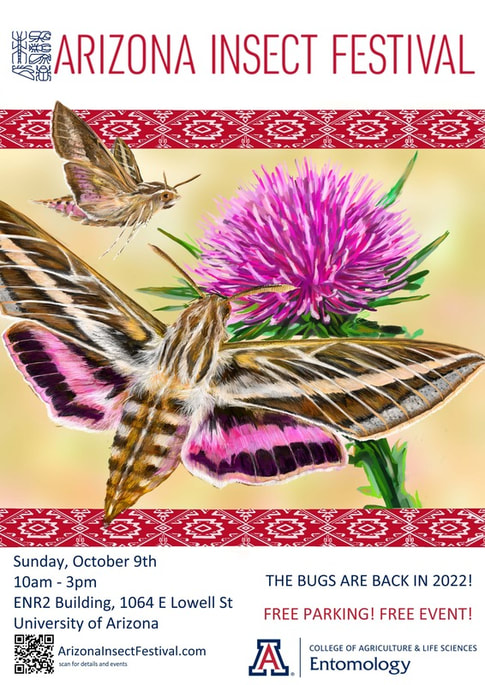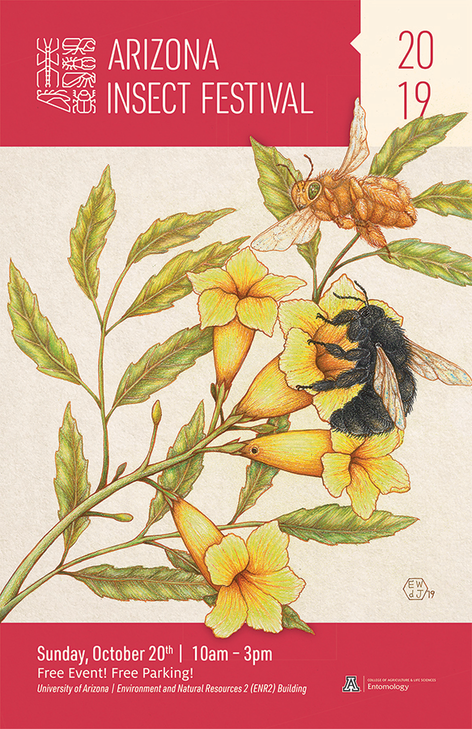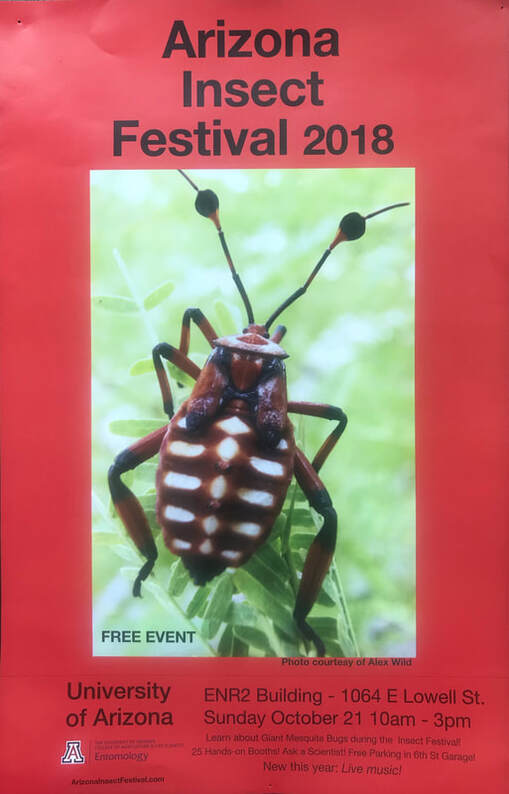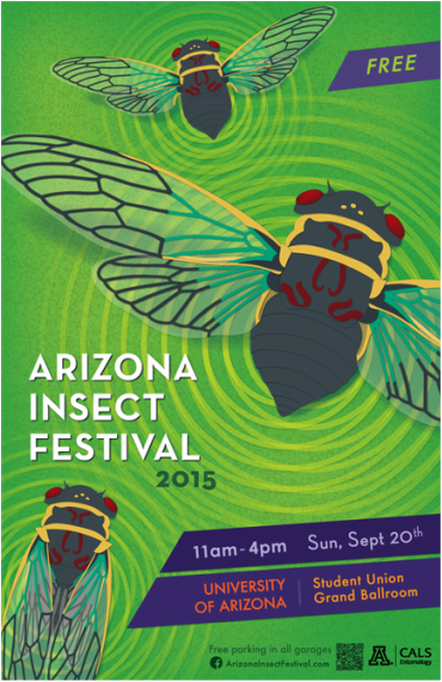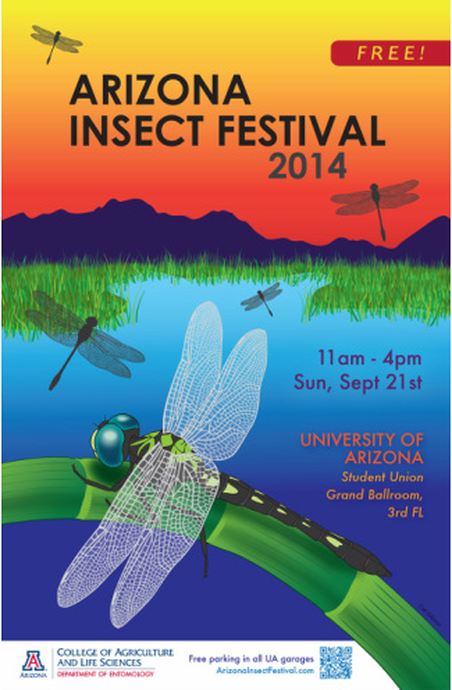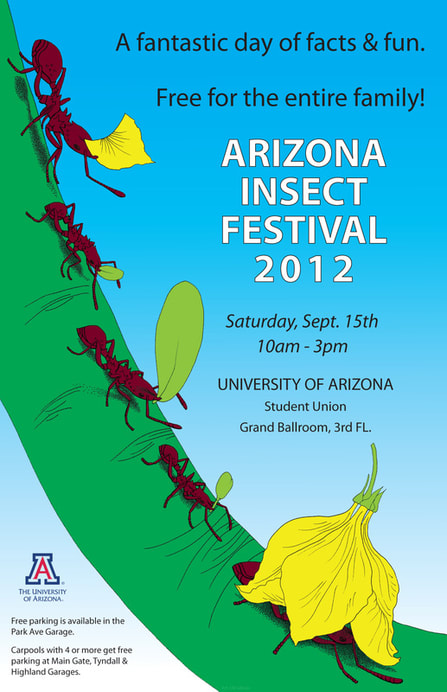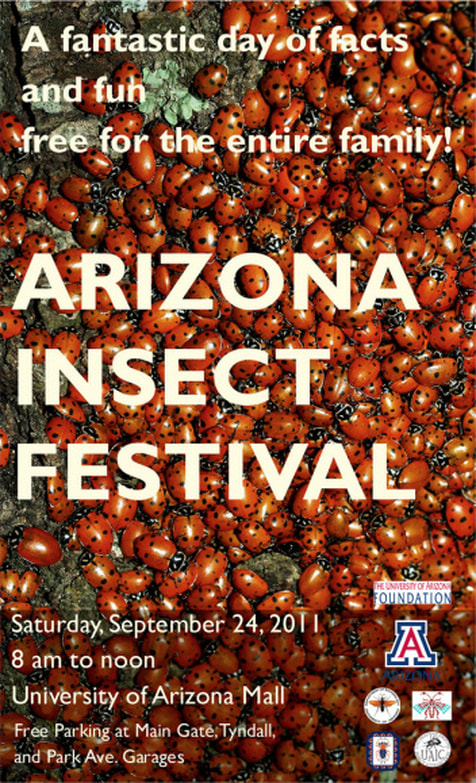From the archives:
|
2022 At a Glance:
25 Booths + Faculty Talks + Graduate Student led 'Ask a Scientist Cafe' 4 Food trucks 150 Faculty, Staff, Post-doctoral Fellows, Students 60 Community Volunteers 4,000 Visitors (approx.)
|
Theme Insect:
The white-lined sphinx moth is sometimes called the hummingbird moth because of its bird-like size and flight pattern. It hovers around flowers sipping nectar all over Tucson, even in the daylight. The species has a broad range across Central and North America, and hordes of caterpillars will sometimes damage crops and gardens. The caterpillars were often skewered and roasted for food by Native Americans.
The white-lined sphinx moth is sometimes called the hummingbird moth because of its bird-like size and flight pattern. It hovers around flowers sipping nectar all over Tucson, even in the daylight. The species has a broad range across Central and North America, and hordes of caterpillars will sometimes damage crops and gardens. The caterpillars were often skewered and roasted for food by Native Americans.
|
2019 At a Glance:
37 Booths + Faculty Talks + Graduate Student led 'Ask a Scientist Cafe' 4 Food trucks + Live Music 175 Faculty, Staff, Post-doctoral Fellows, Students 80 Community Volunteers 5,000 Visitors (approx.) |
Theme Insect:
This year there was no single theme insect - instead we celebrated the surprising fact that more species of native bees (around 1,000) live in and around Tucson than any other place in the world. Unlike honey bees, most bee species are solitary. Moms do all the work, commonly building underground nests where they lay their eggs on top of pollen they have collected to nourish their young. Let's make sure to preserve this amazing natural history!
This year there was no single theme insect - instead we celebrated the surprising fact that more species of native bees (around 1,000) live in and around Tucson than any other place in the world. Unlike honey bees, most bee species are solitary. Moms do all the work, commonly building underground nests where they lay their eggs on top of pollen they have collected to nourish their young. Let's make sure to preserve this amazing natural history!
|
2018 At a Glance:
25 Booths + Faculty talks + Graduate Student led 'Ask a Scientist Cafe' 4 Food trucks 175 Faculty, Staff, Post-doctoral Fellows, Students 75 Community Volunteers 5,000 Visitors (approx.) |
Theme Insect:
The giant mesquite bug (Thasus neocalifornicus) is an insect in the order Hemiptera, or the "true bugs". This is a large leaf-footed bug that feeds on mesquite trees in the American southwest and northwestern Mexico. Hot weather brings giant mesquite bugs down to earth: normally dwellers of the mesquite canopy, the bright red and white nymphs can be seen at the base of mesquite trees all over Tucson. After these harmless critters shed their skins and molt they move back to the treetops to feed on mesquite beans.
The giant mesquite bug (Thasus neocalifornicus) is an insect in the order Hemiptera, or the "true bugs". This is a large leaf-footed bug that feeds on mesquite trees in the American southwest and northwestern Mexico. Hot weather brings giant mesquite bugs down to earth: normally dwellers of the mesquite canopy, the bright red and white nymphs can be seen at the base of mesquite trees all over Tucson. After these harmless critters shed their skins and molt they move back to the treetops to feed on mesquite beans.
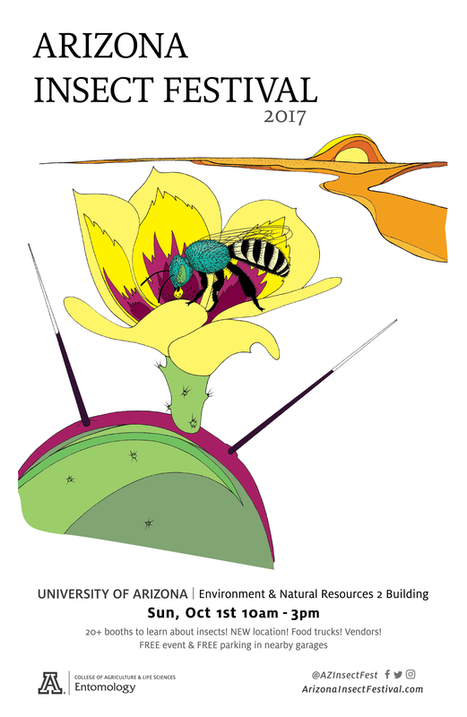 Art: Cara Gibson Art: Cara Gibson
Theme Insect:
The honey-bellied green metallic sweat bee, Agapostemon melliventris. This bee is one of many bee species that is solitary, making individual nests in the ground rather than living in social hives. It is a small bee (1 cm long) that can be attracted to sweat for nutrition, but only bites or stings if provoked. These bees are key pollinators of various cactus species in the Sonoran Desert. |
2017 At a Glance:
27 Booths + Faculty talks + Guest lecturer + Graduate Student led 'Ask a Scientist Cafe' 4 Food trucks 7 Vendors 175 Faculty, Staff, Post-doctoral Fellows, Students 75 Community Volunteers 5,000 Visitors (approx.)
|
|
Theme Insect:
The western hercules beetle, Dynastes grantii. This species is a type of rhinocerus beetle that is native to Arizona and is one of the largest in the US at 5-8 cm long. Males have horns for fighting and females do not. Adults feed on tree sap but are harmless to the tree. Moisture, such as falling rain, causes their grey outer cuticle to turn black. |
2016 At a Glance:
24 Booths + Graduate Student led 'Ask a Scientist Cafe' 150 Faculty, Staff, Post-doctoral Fellows, Students 75 Community Volunteers 5,000 Visitors (approx.) |
|
Theme Insect:
The apache (or citrus) cicada, Diceroprocta apache. Apache cicadas create quite the buzz during sizzling summer days in Tucson and are one of the only insects that sweat. Cicadas feature prominently in Native American mythology, and may be the inspiration for the common “humpbacked flute player” symbol, an anthropomorphic image that symbolizes fertility and reproduction. |
2015 At a Glance:
22 Booths 150 Faculty, Staff, Post-doctoral Fellows, Students 50 Community Volunteers 5,000 Visitors (approx.) |
|
Theme Insect:
The thornbush dasher, Micrathyria hagenii. Dragonflies spend the bulk of their lives as underwater predators - sometimes staying as nymphs for longer than a decade! They emerge and may be seen as adults for as little as a few days or weeks. |
2014 At a Glance:
19 Booths 109 Faculty, Staff, Post-doctoral Fellows, Students 40 Community Volunteers 5,000 Visitors (approx.)
|
|
Theme Insect:
The two-tailed swallowtail Papilio multicaudata. Adult butterflies are out in spring and summer and lay eggs on a variety of host plants, including Arizona rosewood and sycamore. The emerging caterpillars feed on the foliage, folding a host plant's leaves and and securing the bundle with silk for protection. Pupae overwinter and then complete metamorphosis and emerge as adult butterflies in spring. This is the Arizona State butterfly. |
2013 At a Glance:
19 Booths, Lecture room, and Meet the Mascot 121 Faculty, Staff, Post-doctoral Fellows, Students 54 Community Volunteers 5,000 Visitors (approx.) |
|
Theme Insect:
The desert leaf-cutting ant, Acromyrmex versicolor. Some of Earth’s earliest farmers, these ants collect plant tissue to feed to their underground fungal gardens. Trails are fun to watch as workers actively bring provisions into their volcano-shaped nests during the cooler parts of the day. The differently-sized individuals, representing different castes, have different jobs within the colony. They do not bite or sting. |
2012 At a Glance:
25 Booths 121 Faculty, Staff, Post-doctoral Fellows, Students 40 Community Volunteers 3,500 Visitors (approx.)
|
|
2011 At a Glance:
20 Booths 80 Faculty, Staff, Post-doctoral Fellows, Students & Community Volunteers 2,000 Visitors (approx.) |
Theme Insect:
The convergent lady beetle, Hippodamia convergens. One of the most common 'lady bug' species in North America, it is a voracious predator of aphids and other plant pests. A single lady beetle can eat up to 50 aphids per day! This species overwinters in massive aggregations and is found in a variety of habitats. You can even purchase them online to release into your garden.
The convergent lady beetle, Hippodamia convergens. One of the most common 'lady bug' species in North America, it is a voracious predator of aphids and other plant pests. A single lady beetle can eat up to 50 aphids per day! This species overwinters in massive aggregations and is found in a variety of habitats. You can even purchase them online to release into your garden.
Event Feedback
"...kudos for a spectacular event...it was probably the largest outreach event the UA has ever put on..."
Judith Bronstein, University Distinguished Professor, UA Dept. of Ecology and Evolutionary Biology, 2012
"My congratulations on a very successful festival...the place was packed particularly with youth. Fabulous..."
Joy Winzerling, Associate Dean, Career & Academic Services, College of Agriculture and Life Sciences, 2012
"We now have had two wildly successful Insect Festivals. I've seen nothing else to rival the impact of these events on families and especially little kids."
John Hildebrand, UA Regents Professor & Head, Dept. of Neurosciences, 2012
Judith Bronstein, University Distinguished Professor, UA Dept. of Ecology and Evolutionary Biology, 2012
"My congratulations on a very successful festival...the place was packed particularly with youth. Fabulous..."
Joy Winzerling, Associate Dean, Career & Academic Services, College of Agriculture and Life Sciences, 2012
"We now have had two wildly successful Insect Festivals. I've seen nothing else to rival the impact of these events on families and especially little kids."
John Hildebrand, UA Regents Professor & Head, Dept. of Neurosciences, 2012

